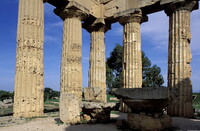| dc.coverage.spatial | Site: Selinunte, Sicily, Italy | en_US |
| dc.coverage.temporal | ca. 470-ca. 450 BCE (creation) | en_US |
| dc.creator | unknown (Greek (ancient)) | en_US |
| dc.date | -470--450 | en_US |
| dc.date.accessioned | 2013-03-27T15:36:15Z | |
| dc.date.available | 2013-03-27T15:36:15Z | |
| dc.date.issued | -470--450 | en_US |
| dc.identifier | 202508 | en_US |
| dc.identifier.other | archrefid: 1225 | en_US |
| dc.identifier.uri | http://hdl.handle.net/1721.3/110463 | |
| dc.description | Northeast corner, from within the temple remains; The Classical Doric style (ca. 525-323 BCE) appeared suddenly at Selinus with Temple E in the eastern sanctuary, dedicated to Hera (ca. 470-ca. 450 BCE; stylobate 25.32 x 67.74 m). The colonnade of massive and closely spaced columns (6 by 15), with single angle contraction at the corners, probably reflects the so-called Temple of Herakles at Akragas (Agrigento) of ca. 500 BCE; the arrangement of the cella, with an adyton as well as standard pronaos and opisthodomos, is a local feature; the strong curvature in the foundations is unique to Selinus, however. The roof tiles were of bronze. Source: Grove Art Online; http://www.groveart.com/ (accessed 8/17/2010) | en_US |
| dc.format.medium | stone | en_US |
| dc.rights | © Scott Gilchrist, Archivision, Inc. | en_US |
| dc.subject | architectural exteriors | en_US |
| dc.subject | deities | en_US |
| dc.subject | mythology (Classical) | en_US |
| dc.subject | Early Classical | en_US |
| dc.title | Selinunte: Temple E | en_US |
| dc.title.alternative | Selinus: Temple E | en_US |
| dc.type | image | en_US |
| dc.rights.access | Licensed for educational and research use by the MIT community only | en_US |
| dc.identifier.vendorcode | 1A3-G-SE-2-E4 | en_US |
| vra.culturalContext | Greek (ancient) | en_US |
| vra.technique | construction (assembling) carving (processes) | en_US |
| vra.worktype | temple | en_US |
| vra.worktype | excavation (site) | en_US |
| dc.contributor.display | unknown (Greek (ancient)) | en_US |


